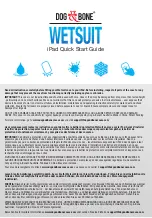
HART Functionality
3-6
Transferring Configurations
to a PC Application
You can transfer configurations (.hcf files) from the 475 Field Communicator to AMS
Device Manager or the Field Communicator Easy Upgrade Utility. After you transfer
the configuration, you can perform different operations depending on the application
used.
AMS Device Manager
Use AMS Device Manager to open, edit, compare, and transfer saved configurations.
A Handheld or Field Communicator Interface kit for AMS Device Manager (version 6.2
or higher) lets you use the 475 Field Communicator with AMS Device Manager.
If the System Card does not appear as a storage location in AMS Device Manager,
copy the configurations from the System Card into the Internal Flash in the 475 Field
Communicator before connecting to AMS Device Manager. See “Copying a Saved
Configuration” on page 3-5 for instructions. Then access the Internal Flash location to
open, edit, and save the configurations in AMS Device Manager. See the AMS Device
Manager Books Online for more information on connecting and transferring
configurations.
Field Communicator Easy Upgrade Utility
Use the Easy Upgrade Utility to back up, transfer, and print the configurations saved in
your 475 Field Communicator. See the Easy Upgrade Utility Help for more information
about connecting and transferring configurations.
WORKING ONLINE WITH
HART DEVICES
Connecting to a HART
Device
The 475 Field Communicator can communicate with a device from the control room,
on the bench, or any wiring termination point in the loop. Connect the 475 Field
Communicator with the appropriate connectors in parallel with the device or load
resistor. The HART connectors are not polarity sensitive.
A minimum of 250 ohms resistance must be present in the HART loop for the 475 Field
Communicator to function properly. For information about Intrinsically Safe
connections, see Appendix B.
HART Communication Terminals
Three terminals for the lead set are on the top of the 475 Field Communicator. Each
red terminal is a positive connection for its protocol. The black terminal is a common
terminal shared by both protocols. An access door ensures only one pair of terminals
is exposed at any one time; see Figure 3-2. Several markings indicate which pair of
terminals is for which protocol.
Summary of Contents for 475
Page 1: ...USER S MANUAL ...
Page 2: ......
Page 4: ...2 ...
Page 10: ...Introduction 1 2 ...
Page 34: ...Learning the Basics 2 24 ...
Page 80: ...Troubleshooting 5 10 ...
Page 93: ...B 7 ...
Page 94: ...B 8 ...
Page 95: ...B 9 ...
Page 96: ...B 10 ...
Page 102: ...C 6 ...
Page 108: ...G vi ...
Page 113: ......
















































